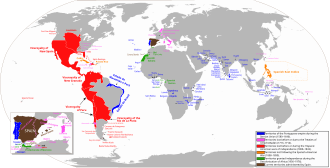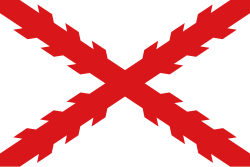Spanish Empire
colonial empire governed by Spain between 1492 and 1976 From Wikipedia, the free encyclopedia
The Spanish Empire, also known as the Hispanic Monarchy or the Catholic Monarchy,[1][2][3] was one of the largest empires in history and one of the first global empires in world history.[4]
This article includes a list of references or other websites, but its sources remain unclear because it does not have enough inline citations. |
Spanish Empire Imperio Español | |||||||||
|---|---|---|---|---|---|---|---|---|---|
| 1492–1899 | |||||||||
|
Cross of Burgundy Flag | |||||||||
 | |||||||||
| Capital | Toledo (1492-1561) Madrid (from 1561) | ||||||||
| Common languages | Spanish | ||||||||
| Religion | Roman Catholic | ||||||||
| Government | Monarchy | ||||||||
| Monarch | |||||||||
• 1516-1556 | Charles I | ||||||||
• 1886-1902 | Maria Christina of Austria, Regent during the minority of king Alphonse XIII | ||||||||
| House of Habsburg | |||||||||
| House of Bourbon | |||||||||
| History | |||||||||
• Invasion of the Americas | 1492 | ||||||||
• Conquest of the Aztec Empire | 1519-1521 | ||||||||
• Conquest of the Inca Empire | 1532–1537 | ||||||||
• Loss of Puerto Rico | 1899 | ||||||||
| Currency | Spanish real, Spanish escudo | ||||||||
| |||||||||
Soon after the Reconquista, Spain became the biggest global empire. It led European exploration of the New World, building the large viceroyalties in the New World. Spain also created the first trade routes across the oceans. The Spanish traded goods across the Atlantic Ocean, between Spain and its viceroyalties in the Americas. They also traded across the Pacific Ocean between Asian and Pacific countries and Mexico throughout the Spanish treasure fleet and the Manila sailing ships.
Spanish conquistadores conquered the Aztecs, Inca and Maya with the help of other Native American tribes and took large areas of land in North America, South America, Asia, Africa and Oceania. Spain made the regions into viceroyalties. Spain, especially the Kingdom of Castile, became much more powerful. Through royal marriages, the Spanish monarchs created alliances with other European powers, which allowed the Spanish Empire to gain control of many territories in Europe. All of those territories and colonies made the Spanish Empire become one of the greatest and richest empires in the world.
For a time, the Spanish Empire was a great power in the oceans, with its experienced navy. Its infantry, which was known as "tercios" and recruited from many countries under the rule of the Spanish monarchy, was undefeated for a century and a half. Spain enjoyed a cultural golden age in the 16th and 17th centuries. The French, Portuguese, and British tried to weaken the Spanish monarchy. Starting in the second half of the 17th century, the Spanish Empire suffered bankruptcies and and lost battles. In the 19th century, Spain lost its last major territories overseas in the Spanish-American War.
Colonization
The Spanish Empire was the second global empire in world history[5] and was scattered all over the world. It was constantly fighting with other powers about territories, trade, or religion. The Spanish Empire fought:
- In the Mediterranean against the Ottoman Empire that threatened Europe and supported Barbary piracy.
- Against France because of the Italian Wars and rival attempts to take the prosperous Italian states.
- Against Britain in the American Revolutionary War[6]
- Against Protestant Leagues in Germany
- Against the Dutch Republic in the Eighty Years' War
- Against England for many reasons over the course of centuries. England joined the Protestant Reformation because of Henry VIII and helped the Dutch Republic rebel against Spain. Theoe efforts ended with the Spanish Armada. Over the years, the British tried to take rich places in the Spanish Americas and succeeded in some such as Jamaica and, during the Seven Years' War, Spanish Florida.
The Spanish Empire slowly lost power, as it gradually lost territory to other empires. In 1648, Spain and many other powers signed the Peace of Westphalia, which ended both the Thirty Years' War and the Eighty Years' War. In 1659, the Treaty of the Pyrenees ended fighting between France and Spain. With those treaties, Spain began to lose its status as the most powerful in Europe.
In 1713, Philip V signed the Peace of Utrecht, which made Spain give up its territories in Italy and The Netherlands. Spain was no longer Europe's greatest power. However, it still had an important role in European politics and a huge empire in the Americas and the Pacific.
During this time, Spain kept its large overseas empire and even made it larger. The Spanish Empire fought against Britain, which was trying to take over more of America; France; and the Netherlands in the New World. Spain remained a major economic power until it lost its colonies in the Americas.
Decolonization
Spain kept control of two colonies in its empire in America: Cuba and Puerto Rico. It also held onto the Philippines and some preserved islands in Oceania, including the Caroline Islands (including the Palau Islands) and the Marianas (including Guam).
When Spain lost the Spanish-American War of 1898, it lost almost all of its last territories. Spain kept control only of small islands of Oceania (not including Guam). Spain sold those islands to Germany in 1899. Spain still kept territories in Africa. Spain controlled part of Morocco, as well as Western Sahara and Equatorial Guinea, until decolonization in the 1960s and the 1970s. The last colony to gain independence was Western Sahara, in 1975, which was soon annexed by Morocco.
Definition
The "Spanish Empire" generally means Spain's overseas provinces in the Americas, Africa, the Pacific and Europe. Territories such as the Low Countries or Spanish Netherlands were included as they were part of the possessions of the King of Spain, governed by Spanish officials and defended by Spanish troops. Many historians use both "Habsburg" and "Spanish" when they speak of the empire of Charles V or Philip II.

The Portuguese Colonial Empire joined Spain and was ruled by the same monarch in "personal union", but Portugal remained a separate state. The Portuguese empire continued to be ruled from Lisbon during this period. There was a joint Spanish-Portuguese rule for some time, which is sometimes called the "Spanish-Portuguese Empire".


In 1492, Spain finished a 781-year period of Reconquista with the fall of the last Moorish kingdom of Granada. The same year, the Catholic Monarchs paid for Christopher Columbus's voyage to reach India by sailing westwards. Columbus instead found America, which was the start of the Spanish colonization of the continent.

By the Treaty of Tordesillas of 1494, the globe was divided into two hemispheres between Spain and Portugal. Therefore, Spain had the right to start colonies in all of the New World from Alaska to Cape Horn (except in Brazil), as well as in Asia. The Castilian Empire was the result of a period of rapid colonial expansion into the New World, as well as the Philippines and colonies in Africa. Melilla was captured by Castile in 1497 and Oran in 1509.
Results until today
The Spanish language and the Roman Catholic Church were brought to the Americas and to the Spanish East Indies (now the Federated States of Micronesia, Guam, Marianas, Palau and the Philippines) by Spanish colonization, which began in the 15th century. Together with the Portuguese Empire, the Spanish Empire laid the foundations of a globalized trade and culture by opening up the great trans-oceanic trade routes. The Laws of the Indies regulated social, political and economic life in the Americas over centuries to protect the Indigenous peoples of the Americas, which started a miscegenation process that was more common than in all of the other empires. The mix between Spaniards, Native Americans and Blacks can be seen in most of the countries that used to be part of the Spanish Empire.
The Spanish Empire left a huge cultural, urban, and architectural legacy in the Western Hemisphere. Hundreds of towns and cities in the Americas were founded during the Spanish rule. The tangible heritage includes universities, forts, cities, cathedrals, schools, hospitals, missions, government buildings and colonial residences, many of which still stand today. Many present-day roads, canals, ports or bridges were built by Spanish engineers centuries ago. The oldest universities in the Americas were founded by Spanish scholars and Catholic missionaries. The Spanish Empire also left a vast cultural and linguistic legacy. With over 470 million native speakers today, Spanish is the second most spoken native language in the world.[7] Another cultural legacy of the Spanish empire overseas is the Catholic Church, which remains the main religion in the Spanish Americas. The cultural legacy is also present in the music, architecture, cuisine and fashion of much of Spanish America.
The Spanish dollar was the world's first global currency.
One of the features of this trade was the exchange of a great array of domesticated plants and animals between the Old World and the New World. Some that were introduced to America included wheat, barley, apples, cattle, sheep, pigs, horses, donkeys, and many others. The Old World received from America maize, potatoes, chili peppers, tomatoes, tobacco, beans, squash, cacao (chocolate), vanilla, avocados, pineapples, chewing gum, rubber, peanuts, cashews, Brazil nuts, pecans, blueberries, strawberries, quinoa, amaranth, chia, and agave.
The exchanges, which are generally known as the Columbian Exchange,[8] had the reusult of improving the agricultural potential of not only America but also Europe and Asia.
Related pages
References
Other websites
Wikiwand - on
Seamless Wikipedia browsing. On steroids.


